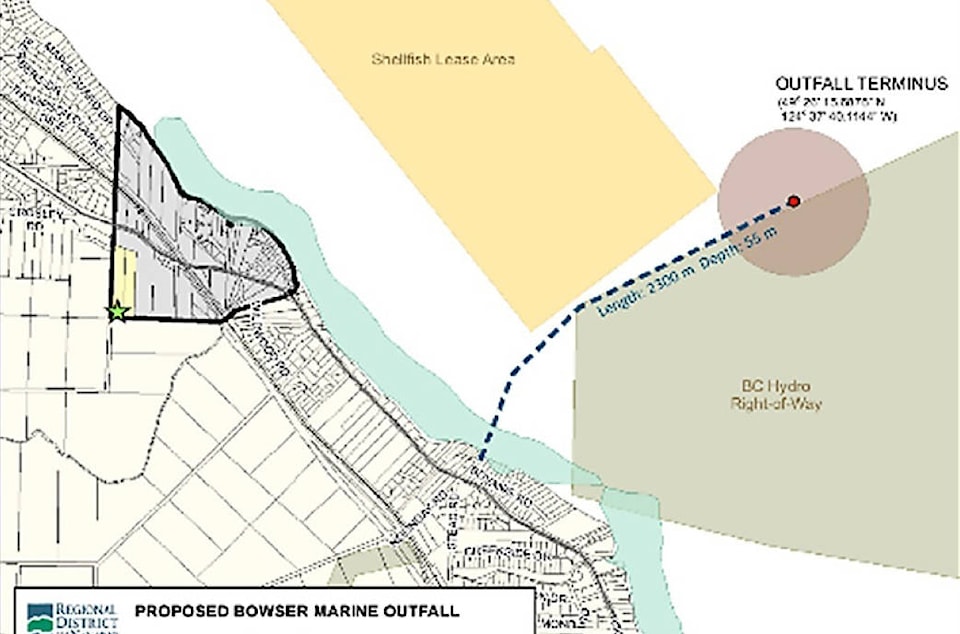Some residents are raising a stink about the Regional District of Nanaimo’s plan to establish a sanitary sewer service for the Bowser Village Centre.
Their biggest concern is the decision to create a sewage outfall in the Strait of Georgia basin as this would impact the environment, the sea habitat as well as the shellfish tenure close by. Some waterfront homeowners regard the beaches there as pristine and popular with tourists.
The RDN have chosen marine disposal over ground disposal due to poor soil conditions and the signficant impact to groundwater. The proposed outfall will be approximately 2.3 kilometres in length offshore, at a depth of approximately 55 metres. It will be located outside the 400 metre offset from any aquaculture leases.
Whether the project will proceed or not will depend on the “petition” process which is designed to get voter assent from Bowser land owners. The deadline to submit the petition is August 11.
Among those opposing this discharge location is Island Scallops Ltd. Todd Russell, general manager, said in his email to The NEWS, “It is almost criminal to put a sewage outfall so close to it.”
Russell said they have transitioned into oyster farming and with the recent norovirus outbreak in B.C. linked to oysters, he fears for the long-term viability of the farm that their company has invested millions of dollars into.
“The treatment plant will not prevent the spread of norovirus which will accumulate in oysters and scallops,” said Russell. “From a public perception point of view, I don’t think our customers will be enthused about eating scallops and oysters so close to a sewer outfall and we will see reduction in sales.”
Russell said RDN staff is aggressively pushing this project through and is “not giving credence to anyone’s concerns.”
“[Electoral Area H] Director Bill Veenhof doesn’t seem to care about supporting the shellfish industry or our community and only wants developers to make money even though we are one of the largest employers in his area,” said Russell.
RDN chair Veenhof said he has always been a strong supporter of the shellfish industry as he is a member of the Department of Fisheries and Ocean’s shellfish advisory committee and has advocated for supportive regulation change with the federal and provincial governments and at the RDN. Veenhoff said the effluent “will be treated to meet or exceed Canadian federal and provincial standards.”
“I would add that, the lateral distance of the outfall from the Island Scallops lease meets the federal and provincial regulations which are designed to protect the industry,” said Veenhof.
In the 2013 Rural Village Centre Study, Bowser had been identified as having the potential to evolve into a small, complete community with services that will benefit all residents from Thames Creek to the Bowser legion. But to achieve this vision, the creation of a sewer service is essential. Veenhoff said it received a strong vote of confidence when the Bowser Village Wastewater Servicing Project was awarded a Clean Water and Wastewater Fund Grant of around $7.6 million last March.
This federal and provincial funding initiative is only good for one year. The estimated cost of the project is $10.7 million — $4,262,962 for the wastewater treatment plant, $3,877,154 for the collection system, and $2,541,395 for marine outfall.
Bowser residents were recently presented with an update on the project by RDN staff and Urban Systems at the public information meeting held July 19 at the Royal Canadian Legion in Bowser. The presentation included procedure and requirements for the new sewer service area, proposed parcel tax rates and methods of payment to fund the non-grant portion of the $10.7 million project, and the sewer servicing design and costs.
One of the highlights of the presentation is the plan to use development cost charges to finance the majority of the costs not covered by the grant, which is around $3.5 million. That would mean less taxes property owners will have to pay.
DCCs will fund 85 per cent of the project or $2.64 million, and the rest will be asborbed by property owners. So instead of paying a one-time fee of $38,000 for a one acre parcel or less, parcel owners will fork out a flat fee of $2,900. For those greater than one acre, owners will pay on a per-square-metre basis at a rate of $0.717 per square metre or $2,900 per acre.
If the petition fails to garner support, Bowser will lose the $7.6 million grant and the project will go down the drain.
Veenhof has told the community what the benefits of the sewage treatment would be. In his message to Bowser residents, he stated, “it will enhance commercial opportunities and services for all of Area H, will be able to build additional housing, have a real opportunity for Bowser Senior’s Housing, have affordable housing, have road improvements, improve storm water drainage, and in the future, become an incorporated rural village.”
